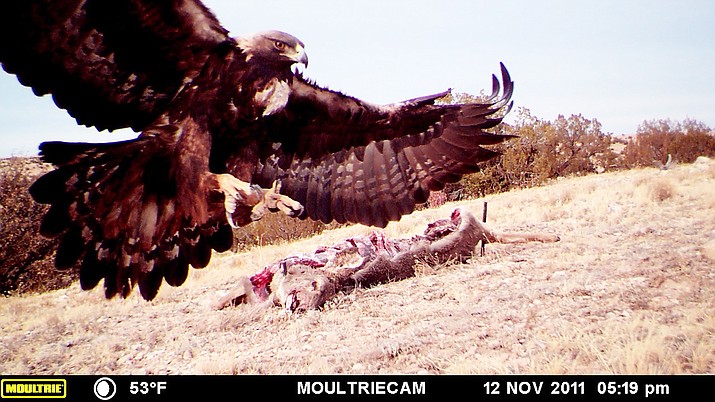SP Crater closed through May to protect nesting golden eagles
FLAGSTAFF, Ariz. – A two-mile area around SP Crater, known as the SP Crater Golden Eagle Conservation Complex (SPEC), currently is off limits to recreationists including hunters, hikers and UTV-ers in an effort to protect golden eagle nests.
Babbitt Ranches, in collaboration with the Arizona Game and Fish Department (AZGFD), has announced special rules in effect for the complex on the CO Bar Ranch. Under the special rules, lead ammunition is strictly forbidden, no target shooting is allowed and no hunting, trapping or other method of taking small game animals is allowed.
“Golden eagles are typically a wilderness species that don’t take well to human activity in and around their nesting territories,” said Arizona Game and Fish Department Raptor Program Coordinator Kenneth Jacobson.
The SP Crater Golden Eagle Conservation Complex was created in 2021, following unique conservation stewardship agreements with the Arizona Game and Fish Department, the Arizona State Land Department and the Landsward Foundation, overseeing the Complex.
“With the growing number of outdoor recreationists in Northern Arizona, along with a concern that golden eagle populations may be declining range wide, the SP Crater Golden Eagle Conservation Complex is designed to keep nesting areas quiet and safe to promote the survival rate of the young and serve as a national model for the protection and sustainability of golden eagle populations,” said Babbitt Ranches President Billy Cordasco.
According to Jacobson, golden eagles will abandon eggs if they feel threatened and, especially in cold weather, it does not take for the eggs to die.
“For hatchlings, it takes about three to four weeks before they have their down to help them thermoregulate,” he said. “If the parent eagles leave the nest when the eaglets are young, they are extremely vulnerable to the elements and predators, like ravens, that will snatch them up in a heartbeat.”
Jacobson added that golden eagles do not lay eggs every year. A recent study by AZGFD found that golden eagle pairs on average produce one nestling every two years.
Cordasco says the SP Crater Golden Eagle Conservation Complex is being tested as a proof of concept to provide protection for golden eagles beyond Northern Arizona.
“If we can manage human activity on the landscape during critical times and promote non-lead ammunition use, we may be able to minimize threats to eagles and improve their production rate and survivability,” he said.
According to Cordasco, years of research and educational efforts spearheaded by The Peregrine Fund’s CEO and President Chris Parish paved the way for the Babbitts and other landowners to manage the use of lead ammunition on their property, supported by the AZGFD. Through Parish’s work with the endangered California condor, research revealed that lead from bullets in the remains of animals left on the landscape and eaten by scavengers, could result in a lethal amount of lead poisoning in birds of prey.
“Our goal is to provide adequate information so folks can make informed decisions, whether choosing the type of ammunition used or engaging in educational campaigns for decreased lead use for wildlife,” Parish said. “We’re not telling people how to manage their land or how to manage hunters, we’re trying to get the scientific information out there so people are more informed.”
Parish co-founded the North American Non-Lead Partnership, an organization with members like Babbitt Ranches, supported by hunters.
“We promote voluntary incentive-based actions and have found that when hunters know what the science says about potential impacts of lead ammunition on wildlife, 80 percent or more take action.”
Golden eagles are large, long-lived raptors found in the high-desert grasslands of the West. Some are in Northern Arizona year round. Others spend the summer as far north as the Yukon.
Babbitt Ranches has been studying eagles across its 750,000-acre rangeland for more than a decade.
SUBMIT FEEDBACK
Click Below to:




